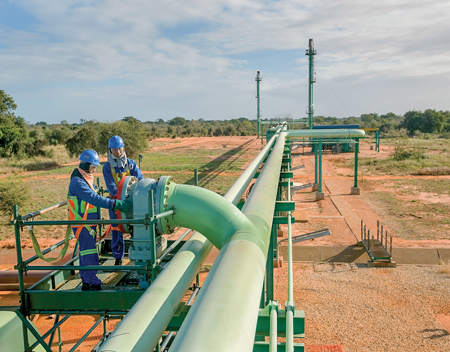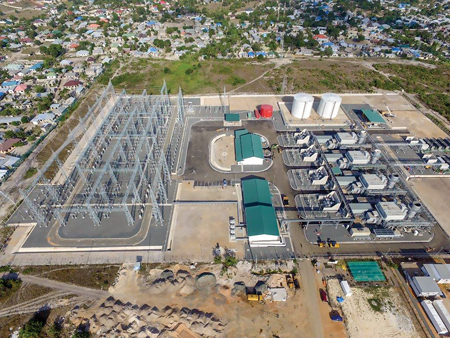Power, LNG projects drive pipeline construction in Africa
Increasing public investment in gas-fired power plants in Africa, the continuing recovery in global oil prices and persistent insecurity in key producer markets, such as Nigeria, are likely to impact gas transmission pipeline projects on the continent, even as more international companies express interest in the region’s stranded gas resources.
Countries where domestic or cross-boundary gas transmission lines already exist, such as Tanzania, Mozambique, South Africa, Algeria, Angola and Egypt, are likely to focus more on improving contract terms and maintenance procedures for existing pipelines to optimize infrastructure performance. Over the medium term, construction of new gas-fueled electricity generation capacity and the expansion of existing power stations are expected to inform countries’ decisions on where and how to invest in gas transmission lines.
Pipeline works in South Africa and Mozambique. Transmission lines remain one of the core components in the success of gas-fired power plants, such as those being developed in Mozambique. The southern African country, with an estimated 160 Tft³ of recoverable gas in the Rovuma offshore basin, recently brought online the 120-MW Ressano Garcia gas-fired power plant project. The capacity exists to expand the power generation facility by another 100 MW in subsequent phases. Mozambique is also debating what to do with two other stalled gas-fired projects in Palma and Gaza, which have planned capacities of 75 MW and 40 MW, respectively.
A growing gas market in neighboring South Africa has spurred the construction of a 2,600-km, large-diameter pipeline to transport natural gas from Mozambique’s Rovuma basin to Gauteng. SacOil Holdings Ltd., a South Africa-based independent oil and gas firm, is heading up the $6-B project.
The pipeline is expected to contribute substantially to the success of South Africa’s planned procurement of 3,126 MW of new electricity generating capacity from gas-fired plants by independent power producers. The electricity will be sold to South Africa’s power utility, Eskom, under 20-yr power purchase agreements. At present, natural gas from the Temane field in Mozambique is transported by petrochemicals company Sasol via an 865-km pipeline (Fig. 1) that terminates at the company’s Secunda plant in South Africa.
 |
| FIG. 1. A portion of the gas pipeline that connects the Temane gas field in Mozambique to the Secunda CTL synthetic fuel plant in South Africa. Photo courtesy of SacOil Ltd. |
Tanzania’s growing gas-to-power sector. Tanzania is also scaling up electricity generation from gas-fired power stations as the country intensifies the monetization of its recoverable natural gas reserves, estimated at more than 57 Tft³. Gas from the country’s Songo Songo Island gas fields is being used to generate electricity by Dar es Salaam-based Songas Ltd., which operates as a subsidiary of Globeleq Generation Ltd. Songas processes the gas and then transports it through a 225-km pipeline to Dar es Salaam to power the Ubungo power station, the largest of its kind in East Africa.
Another 542-km gas transmission line has been constructed to transport gas from the Mtwara and Lindi regions to Dar es Salaam for electricity generation, for power to industrial plants and for household consumption. One of the facilities to be powered by the gas transported via this pipeline is the Kinyerezi gas-fired power complex in Dar es Salaam. State-run utility Tanzania Electric Supply Co. Ltd. is expanding the Kinyerezi I power plant (Fig. 2) to 335 MW from the existing capacity of 150 MW. The expansion is expected to be completed by February 2019. The piped gas is also expected to power the Kinyerezi II station, which is being expanded to its full capacity of 240 MW. Future plans include the construction of Kinyerezi III and Kinyerezi IV plants, with respective capacities of 600 MW and 450 MW.
 |
| FIG. 2. Kinyerezi I gas-fired plant at Dar es Salaam, Tanzania. |
More gas transmission lines are anticipated under Tanzania’s electricity generation master plan, implemented by Tanzania Petroleum Development Corp. (TPDC). TPDC targets 2,000 MW of new gas-fired electricity generation capacity by the end of 2018 and a total of 10,000 MW of power generation capacity by 2025.
LNG pipeline development for Angola. To the south, oil-rich Angola is constructing a 500-km network of gas pipelines to link the offshore gas producing blocks 15, 17 and 18 to the liquefaction plant at Soyo. An additional subsea pipeline will link blocks 0 and 14 to the gas processing facility.
The project is part of the $10-B Angola LNG project being developed under a partnership between Sonangol and a consortium of Chevron, BP, Eni and Total for the purpose of creating value addition for the country’s natural gas resources. Along with gathering, processing and delivering gas to the global market through an estimated 5.2 MMtpy of LNG, the project is expected to supply enough gas for electricity generation for industrial and domestic consumption, as well as for the production of condensate, propane and butane.
In late 2017, Angola LNG announced the completion of a 16-km gas pipeline project to connect its liquefaction facility at Soyo to a combined-cycle power station in the northern province of Zaire.
Whereas the influence of increased investments in gas-fired power plants is a motivation for international greenfield pipeline project developers interested in Africa, the trend is slightly different in gas-rich Nigeria, where persistent insecurity has left few gas pipeline investment options on the table.
Nigeria relies on gas to meet nearly 44% of its total energy demand, with about 95% of the country’s installed thermal power plant capacity powered by natural gas. The gas is largely produced in the Niger Delta region, where incidents of vandalism of gas supply infrastructure have increased, reducing power supply and causing social and economic losses.
Despite the challenges in the Niger Delta, Nigeria aims to make additional investments in gas transmission lines to feed planned power plants. Nigeria has a thermal installed capacity of 12,000 MW. This capacity requires approximately 2,734 MMsft3d of gas to efficiently operate, of which a mere 820.2 MMsft3d, or 30%, is available. The shortage is partly due to the unreliable supply from frequently sabotaged gas pipelines. Nigeria’s Central Bank has noted that the infrastructure security challenges have prompted some international oil majors operating in Nigeria to divest their interests in offshore and shallow-water oil and gas blocks.
IOCs continue to invest in Africa. Despite security and logistical challenges in some countries, new discoveries in both emerging and mature gas markets in Africa continue to attract the interest of international energy producers and pipeline companies. New gas discoveries in hydrocarbon-rich countries, particularly Egypt, could drive a new wave of investment in gas transmission lines.
Italian oil and gas company Eni has announced natural gas discoveries in excess of 850 Bm3 (30 Tft3) in Egypt’s Zohr field. New gas pipelines are expected to be constructed to move gas to Egypt’s power plants, industries and homes. Project developers, including BP Plc and Russia’s largest oil producer, Rosneft, are scaling up production at the gas field for use by both the domestic and international markets.
Africa’s natural gas resources have attracted interest from international exploration and production companies keen on meeting demand for commodities in growing markets, such as China and India. This is likely to drive construction of onshore pipelines connecting gas production fields to liquefaction and processing plants. GP
 |
Shem Oirere is a freelance journalist based in Nairobi, Kenya. He has spent more than 10 yr covering various sectors of Africa’s economy, and has had numerous articles published in several international publications and websites. Previously, Mr. Oirere worked for Kenyan national newspapers, including the Daily Nation, Kenya Times and People Daily, where he served in various capacities as correspondent, business reporter and sub-editor. He earned a higher degree in journalism from the London School of Journalism, and is also a member of the Association of Business Executives (ABE).




Comments